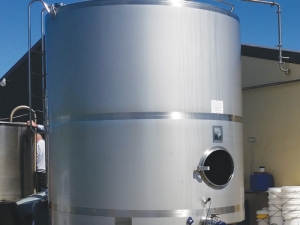Brainwave leads to money-saving device
It all started on the farm of Brad Sulzberger in Urenui, Taranaki, as he pondered his two-day collectioin and keeping the milk cool.
 Low milk prices for the past two seasons are forcing farmers to postpone spending on new milk cooling systems.
Low milk prices for the past two seasons are forcing farmers to postpone spending on new milk cooling systems.
Dairy farmers will need more time to upgrade milk cooling systems to align them with proposed new regulations.
Low milk prices for the past two seasons are forcing farmers to postpone spending on new milk cooling systems.
The new rules will take effect on August 1 for new farm dairies or dairies making significant changes to their refrigeration system. For existing dairies the new rules will now apply from June 1, 2018.
Cost for each farm will vary depending on herd size; some farms could upgrade their current coolers but a new system would cost $8000 to$25,000.
According to milk cooling technology providers, most farmers seem to be waiting for their incomes to improve.
The Ministry of Primary Industries, which sets the new regulations, says it started discussions with the industry about three years ago and implemented a long transition period. The regulations will ensure New Zealand maintains its global position as a producer of top quality milk.
Dairy Cooling Solutions, a division of Eurotec, reports those who can afford it are responding positively but most farmers are waiting for income to improve.
Eurotec sales and marketing manager Chris Farmer believes it's inevitable that an extension will have to be granted.
"The current suppliers of milk cooling equipment including ourselves could not realistically meet demand before the due date if farmers decided to upgrade today.
"With potentially 4000-5000 farms across the country requiring upgrades to their refrigeration in 18 months, it's not possible."
Steve Corkill, Corkill Systems, agrees.
"Most are holding back due to having no money and are waiting to see what other options become available; they are also aware that currently Fonterra has no way to monitor their systems so are doing only the minimum to get the best from what they have."
He supports an extension.
"Yes, the time could be extended as Fonterra has currently no way to monitor vats and it will take time to have this set up nationally.
"If the farmer is knowingly outside the requirements he probably needs to act (Fonterra can do individual temporary monitoring now); anyone marginal has time to see what else appears in the market and can play with optimising their current systems."
To help cash-strapped farmers, companies are offering easier payment terms.
Taranaki-based James Thomas, Dairychill, believes farmers are taking the issue very seriously.
"We are currently finding that farmers are reacting on the whole very well and responsibly with the current squeeze.
"Our systems and payment terms over the last year have been tailored to help out. They make this easier to put in and also ensure there is a payback for the customer so they save money on kW/h of power used -- important for any business."
Thomas says some farmers already comply with the regulations. But anytime is a good time to improve cooling and save power, he says.
"It's a positive thing that farmers are looking at payment terms to help with downturn."
The new MPI regulations require farmers to hold milk at 6 deg C or cooler until the tanker collects. Present rules allow milk to be cooled to 7 deg C within three hours of milking and until collection. In Australia milk must be cooled to 5 deg C within 3.5 hours of milking; in China to 4 deg C within two hours of milking. In the EU, milk collected daily must be kept at no more than 6 deg C if not collected daily.
Consult before you spend
MPI says various options are available to farmers.
Director, animal and animal products, Mathew Stone, says to ensure farmers find a cost effective solution MPI recommends they consult their dairy company, refrigeration service provider, farm dairy assessor and the EECA website before committing to spending money.
"It is an individual farmer's responsibility to meet the costs, though in some cases their processor has a joint responsibility," says Stone.
The National Wild Goat Hunting Competition has removed 33,418 wild goats over the past three years.
New Zealand needs a new healthcare model to address rising rates of obesity in rural communities, with the current system leaving many patients unable to access effective treatment or long-term support, warn GPs.
Southland farmers are being urged to put safety first, following a spike in tip offs about risky handling of wind-damaged trees
Third-generation Ashburton dairy farmers TJ and Mark Stewart are no strangers to adapting and evolving.
When American retail giant Cosco came to audit Open Country Dairy’s new butter plant at the Waharoa site and give the green light to supply their American stores, they allowed themselves a week for the exercise.
Fonterra chair Peter McBride says the divestment of Mainland Group is their last significant asset sale and signals the end of structural changes.
President Donald Trump’s decision to impose tariffs on imports into the US is doing good things for global trade, according…
Seen a giant cheese roll rolling along Southland’s roads?